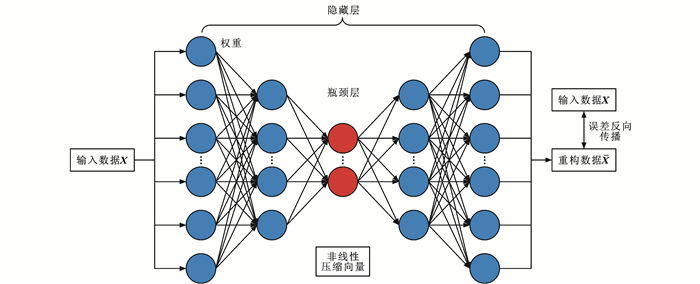Aircraft trajectory clustering in terminal area and anomaly recognition based on density peak
-
摘要: 为有效解决高流量终端区内标准飞行模式、非标准飞行模式和异常飞行模式难以自动分离的问题,采用广泛记录的广播式自动相关监视(ADS-B)数据,构建了基于稳健深度自编码器(RDAE)和快速搜索并寻找密度峰值的聚类(CFSFDP)算法的航迹聚类模型; 使用RDAE降维提取终端区内航迹集的非线性特征,利用多种正则化手段约束内部低维流形,以重建更紧密的航迹并将其作为CFSFDP算法的输入,利用轮廓系数选取不同密度飞行模式的聚类中心,并调节边缘密度参数识别出异常航迹; 选取主成分分析(PCA)结合有噪声的空间密度聚类(DBSCAN)算法、动态时间规整(DTW)结合DBSCAN的2种常用航迹聚类模型作为对比项,分别在广州白云机场1 d的少量数据和45 d的大量数据上进行试验。分析结果表明:DTW与CFSFDP的结合模型在少量数据集上具有最优的航迹聚类性能,轮廓系数比对比项分别提升了62%和28%,且可以自动识别出遵循区域导航标准飞行模式的航班和特定环境下遵循管制偏好的非标准飞行模式的航班,识别异常航迹的精确度也分别提高了57%和10%;大量数据下,提出的RDAE结合CFSFDP模型的聚类性能比经典的PCA结合DBSCAN算法提升了13%,且具备可接受的时间复杂度。由此可见,建立的终端区飞行模式区分模型可为空域级交通流性能评估和航班级航迹预测与优化提供数据提取平台。Abstract: To effectively solve the problem that it is difficult to automatically separate the standard flight, non-standard flight and anomalous flight patterns in high-traffic terminal areas, an aircraft trajectory clustering model was established based on the robust deep auto-encoder (RDAE) and clustering by fast search and find of density peaks (CFSFDP) using the widely recorded automatic dependent surveillance-broadcast (ADS-B) data. The RDAE was designed to reduce the dimensionality and extract nonlinear features from the aircraft trajectory dataset of terminal areas, while various regularization methods were adopted to constrain the internal low-dimensional manifolds to reconstruct a denser aircraft trajectory, and the aircraft trajectory was input to the CFSFDP algorithm. The silhouette coefficient was used to select the cluster centers for flight patterns with different densities and recognize anomalous trajectories by adjusting the edge density parameter. Two widely used aircraft trajectory clustering models, namely principal component analysis (PCA) combined with density-based spatial clustering of applications with noise (DBSCAN) as well as dynamic time wrapping (DTW) combined with DBSCAN, were taken as comparisons. Experiments were conducted on a small data of 1 d and a large data of 45 d of Guangzhou Baiyun Airport. Analysis results demonstrate that the model combining DTW and CFSFDP provides the best aircraft trajectory clustering performance on the small data, and the silhouette coefficient is 62% and 28% higher than those of comparisons, respectively. The DTW/CFSFDP model can automatically recognize standard flights following the area navigation procedures and non-standard flights that reflect controllers' preferences in specific environments, and the accuracies for identifying anomalous aircraft trajectories also improve by 57% and 10%, respectively. For the large data, the clustering performance of the proposed RDAE/CFSFDP model improves by 13% compared to that of the classical PCA/DBSCAN algorithm. Further, the proposed model exhibits acceptable time complexity. In summary, the established flight pattern discrimination model for terminal areas can provide a data extraction platform for the airspace-level traffic flow performance evaluation and the flight-level aircraft trajectory prediction and optimization. 2 tabs, 10 figs, 31 refs.
-
表 1 聚类算法超参数网格
Table 1. Hyperparameters grids of clustering algorithm
算法 超参数网格 DBSCAN μ={0.001, 0.01, 0.1, 1, 1.5, 2, 4, 10}
η={5, 6, 7, 8, 9, 10, 11, 12, 13, 14, 15}CFSFDP φ={0.01, 0.1, 0.2, 0.4, 0.7, 1} 表 2 各异常航迹识别算法的最优结果
Table 2. Optimal results of different algorithms for anomalous aircraft trajectory recognition
算法 精确率/% 召回率/% F1分数 轮廓系数 PCA结合DBSCAN (最优异常精确度) 56.1 62.7 0.592 0.37 PCA结合DBSCAN (最优轮廓系数) 52.9 18.8 0.277 0.42 DTW结合DBSCAN 89.1 80.4 0.845 0.53 RDAE结合CFSFDP 79.5 76.5 0.779 0.62 DTW结合CFSFDP 95.8 90.2 0.929 0.68 -
[1] EUROCONTRO L. EUROCONTRO L Specification for trajectory prediction[R]. Brussels: EUROCONTROL, 2017. [2] BASORA L, OLIVE X, DUBOT T. Recent advances in anomaly detection methods applied to aviation[J]. Aerospace, 2019, 6(11): 117. doi: 10.3390/aerospace6110117 [3] MURÇA M C R, HANSMAN R J. Predicting and planning airport acceptance rates in metroplex systems for improved traffic flow management decision support[J]. Transportation Research Part C: Emerging Technologies, 2018, 97: 301-323. doi: 10.1016/j.trc.2018.10.020 [4] ECKSTEIN A. Automated flight track taxonomy for measuring benefits from performance based navigation[C]//CLARK R. 2009 Integrated Communications, Navigation and Surveillance Conference. New York: Institute of Electrical and Electronics Engineers, 2009: 1-12. [5] REHM F. Clustering of flight tracks[C]//ERIC J. American Institute of Aeronautics and Astronautics Infotech at Aerospace 2010. Atlanta: American Institute of Aeronautics and Astronautics, 2010: 1-9. [6] ENRIQUEZ M. Identifying temporally persistent flows in the terminal airspace via spectral clustering[C]// SAUNDERS-HODGE A. Proceedings of the 10th USA/Europe Air Traffic Management Research and Development Seminar. Chicago: Federal Aviation Administration, 2013: 10-13. [7] GARIEL M, SRIVASTAVA A N, FERON E. Trajectory clustering and an application to airspace monitoring[J]. IEEE Transactions on Intelligent Transportation Systems, 2011, 12(4): 1511-1524. doi: 10.1109/TITS.2011.2160628 [8] GARIEL M. Toward a graceful degradation of air traffic management systems[D]. Atlanta: Georgia Institute of Technology, 2010. [9] ARNESON H, BOMBELLI A, SEGARRA-TORNE A, et al. Analysis of convective-weather impact on pre-departure routing decisions for flights traveling between Fort Worth Center and New York Air Center[C]//HANSMAN R J. 17th AIAA Aviation Technology, Integration, and Operations Conference. Richmond: American Institute of Aeronautics and Astronautics, 2017: 3084-3096. [10] MARZUOLI A, GARIEL M, VELA A, et al. Data-based modeling and optimization of en-route traffic[J]. Journal of Guidance, Control, and Dynamics, 2014, 37(6): 1930-1945. doi: 10.2514/1.G000010 [11] BOMBELLI A, SOLER L, TRUMBAUER E, et al. Strategic air traffic planning with Fréchet distance aggregation and rerouting[J]. Journal of Guidance, Control, and Dynamics, 2017, 40(5): 1117-1129. doi: 10.2514/1.G002308 [12] ANDRIENKO G, ANDRIENKO N, FUCHS G, et al. Clustering trajectories by relevant parts for air traffic analysis[J]. IEEE Transactions on Visualization and Computer Graphics, 2018, 24(1): 34-44. doi: 10.1109/TVCG.2017.2744322 [13] LI Li-shuai, GARIEL M, HANSMAN R J, et al. Anomaly detection in onboard-recorded flight data using cluster analysis[C]//ELLIS H. IEEE/AIAA 30th Digital Avionics Systems Conference. Norfolk: Institute of Electrical and Electronics Engineers. 2011: 4A4-1-11. [14] LI Li-shuai, HANSMAN R J, PALACIOS R, et al. Anomaly detection via a Gaussian mixture model for flight operation and safety monitoring[J]. Transportation Research Part C: Emerging Technologies, 2016, 64: 45-57. doi: 10.1016/j.trc.2016.01.007 [15] HONG S, LEE K. Trajectory prediction for vectored area navigation arrivals[J]. Journal of Aerospace Information Systems, 2015, 12(7): 490-502. doi: 10.2514/1.I010245 [16] DELAHAYE D, PUECHMOREL S, ALAM S, et al. Trajectory mathematical distance applied to airspace major flows extraction[C]//ABBUD J. Electronic Navigation Research Institute Air Traffic Management and Systems Ⅲ. Berlin: Springer, 2019: 51-66. [17] 王超, 韩邦村, 王飞. 基于轨迹谱聚类的终端区盛行交通流识别方法[J]. 西南交通大学学报, 2014, 49(3): 546-552. doi: 10.3969/j.issn.0258-2724.2014.03.027WANG Chao, HAN Bang-cun, WANG Fei. Identification of prevalent air traffic flow in terminal airspace based on trajectory spectral clustering[J]. Journal of Southwest Jiaotong University, 2014, 49(3): 546-552. (in Chinese) doi: 10.3969/j.issn.0258-2724.2014.03.027 [18] 熊伟, 顾祥岐, 徐从安, 等. 基于高斯混合EM聚类的多编队航迹起始方法[J]. 系统工程与电子技术, 2019, 41(11): 2424-2430. https://www.cnki.com.cn/Article/CJFDTOTAL-XTYD201911004.htmXIONG Wei, GU Xiang-qi, XU Cong-an, et al. Multi-formation track initiation method based on Gaussian mixture EM clustering[J]. Systems Engineering and Electronics, 2019, 41(11): 2424-2430. (in Chinese) https://www.cnki.com.cn/Article/CJFDTOTAL-XTYD201911004.htm [19] 王超, 徐肖豪, 王飞. 基于航迹聚类的终端区进场程序管制适用性分析[J]. 南京航空航天大学学报, 2013, 45(1): 130-139. doi: 10.3969/j.issn.1005-2615.2013.01.022WANG Chao, XU Xiao-hao, WANG Fei. ATC serviceability analysis of terminal arrival procedures using trajectory clustering[J]. Journal of Nanjing University of Aeronautics and Astronautics, 2013, 45(1): 130-139. (in Chinese) doi: 10.3969/j.issn.1005-2615.2013.01.022 [20] 徐涛, 陈雪蕊, 吕宗平. 基于航迹聚类的终端区飞行程序轨迹表示[J]. 四川大学学报(工程科学版), 2016, 48(6): 188-196. https://www.cnki.com.cn/Article/CJFDTOTAL-SCLH201606026.htmXU Tao, CHEN Xue-rui, LYU Zong-ping. Flight procedure representation of terminal area based on flight tracks clustering[J]. Advanced Engineering Sciences, 2016, 48(6): 188-196. (in Chinese) https://www.cnki.com.cn/Article/CJFDTOTAL-SCLH201606026.htm [21] SABHNANI G R, YOUSEFI A, KOSTITSYNA I, et al. Algorithmic traffic abstraction and its application to NextGen generic airspace[C]//BALAKRISHINAN H. 10th AIAA Aviation Technology, Integration and Operations Conference 2010, Richmond: AIAA, 2010: 9335-9345 [22] MAHBOUBI Z, KOCHENDERFER M J. Learning traffic patterns at small airports from flight tracks[J]. IEEE Transactions on Intelligent Transportation Systems, 2017, 18(4): 917-926. doi: 10.1109/TITS.2016.2598064 [23] MURÇA M C R, HANSMAN R J, LI L, et al. Flight trajectory data analytics for characterization of air traffic flows: a comparative analysis of terminal area operations between New York, Hong Kong and Sao Paulo[J]. Transportation Research Part C: Emerging Technologies, 2018, 97: 324-347. doi: 10.1016/j.trc.2018.10.021 [24] OLIVE X, GRIGNARD J, DUBOT T, et al. Detecting controllers' actions in past mode S data by autoencoder-based anomaly detection[C]//DIRK S. SESAR Innovation Days 2018. Brussels: EUROCONTROL, 2018: 1-9. [25] GALLEGO C E V, GOMEZ COMENDADOR V F, SAEZ NIETO F J, et al. Discussion on density-based clustering methods applied for automated identification of airspace flows[C]//GEORGE A. IEEE/AIAA 37th Digital Avionics Systems Conference (DASC). London: Institute of Electrical and Electronics Engineers, 2018: 1-10. [26] ZHANG W, TAN X. Combining outlier detection and reconstruction error minimization for label noise reduction[C]// MASATOSHI A. 2019 IEEE International Conference on Big Data and Smart Computing. New York: IEEE, 2019: 1-4. [27] HINTON G E, SALAKHUTDINOV R R. Reducing the dimensionality of data with neural networks[J]. Science, 2006, 313(5786): 504-507. doi: 10.1126/science.1127647 [28] ZHOU Chong, PAFFENROTH R C. Anomaly detection with robust deep autoencoders[C]//YU Shi-peng. Proceedings of the 23rd ACM SIGKDD International Conference on Knowledge Discovery and Data Mining. Halifax: Association for Computing Machinery, 2017: 665-674. [29] PAFFENROTH R, TOIT P, NONG R, et al. Space-time signal processing for distributed pattern detection in sensor networks[J]. IEEE Journal of Selected Topics in Signal Processing, 2013, 7(1): 38-49. doi: 10.1109/JSTSP.2012.2237381 [30] RODRIGUEZ A, LAIO A. Clustering by fast search and find of density peaks[J]. Science, 2014, 344(6191): 1492. doi: 10.1126/science.1242072 [31] SCHUBERT E, SANDER J, ESTER M, et al. DBSCAN revisited, revisited: why and how you should (still) use DBSCAN[J]. ACM Transactions on Database Systems, 2017, 42(3): 19. -





 下载:
下载:











